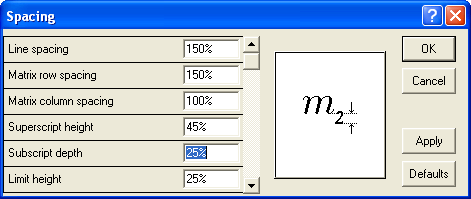Written by Allen Wyatt (last updated January 6, 2024)
This tip applies to Word 97, 2000, 2002, and 2003
When using the Equation Editor, you can control the spacing applied by the Equation Editor between the baseline of a character in an equation and the baseline of a subscript to that character. The value you specify represents a percentage of the normal baseline spacing. Thus, a setting of 10% represents a spacing that is 1/10 the normal baseline distance. You can set this adjustment by following these steps:

Figure 1. The Subscript depth box of the Spacing dialog box.
WordTips is your source for cost-effective Microsoft Word training. (Microsoft Word is the most popular word processing software in the world.) This tip (927) applies to Microsoft Word 97, 2000, 2002, and 2003.

Learning Made Easy! Quickly teach yourself how to format, publish, and share your content using Word 2021 or Microsoft 365. With Step by Step, you set the pace, building and practicing the skills you need, just when you need them! Check out Microsoft Word Step by Step today!
If you are using matrices in your equations, you may want to adjust the spacing used between columns.
Discover MoreThe Equation Editor can be a great boon when you need to include complex mathematical equations in your document. The ...
Discover MoreThe Equation Editor is a handy tool, particularly for those who must include mathematical equations in their documents. ...
Discover MoreFREE SERVICE: Get tips like this every week in WordTips, a free productivity newsletter. Enter your address and click "Subscribe."
There are currently no comments for this tip. (Be the first to leave your comment—just use the simple form above!)
Got a version of Word that uses the menu interface (Word 97, Word 2000, Word 2002, or Word 2003)? This site is for you! If you use a later version of Word, visit our WordTips site focusing on the ribbon interface.
Visit the WordTips channel on YouTube
FREE SERVICE: Get tips like this every week in WordTips, a free productivity newsletter. Enter your address and click "Subscribe."
Copyright © 2025 Sharon Parq Associates, Inc.
Comments